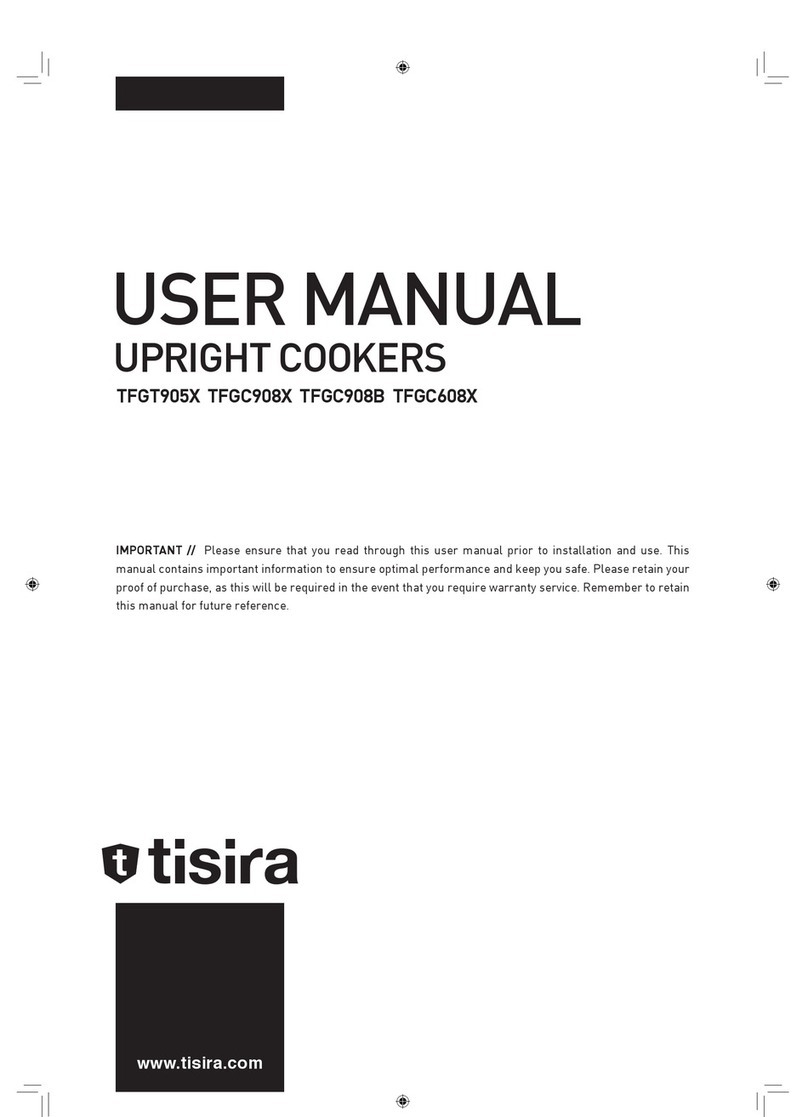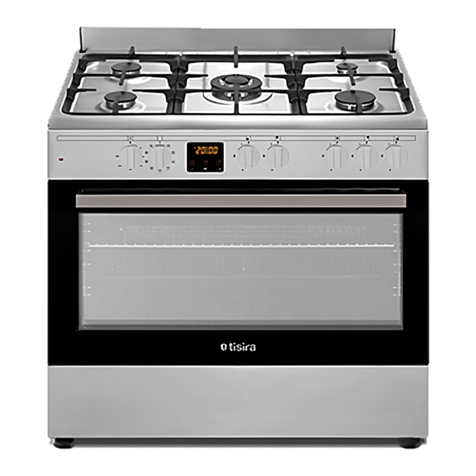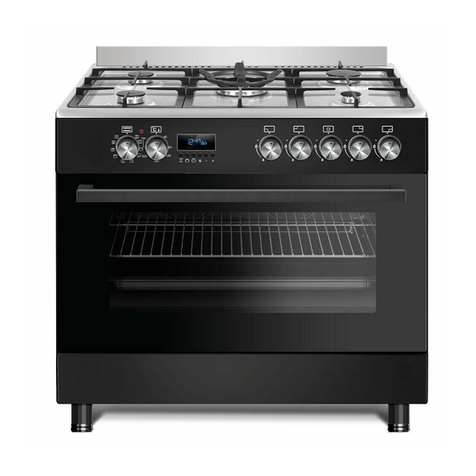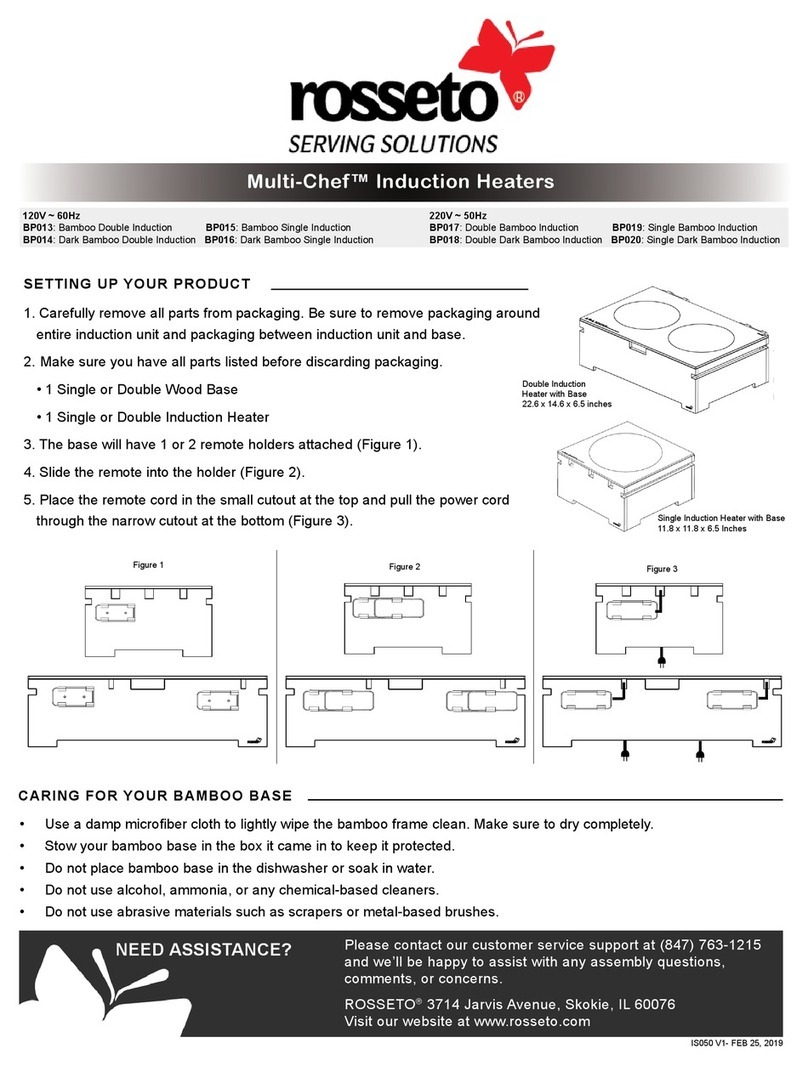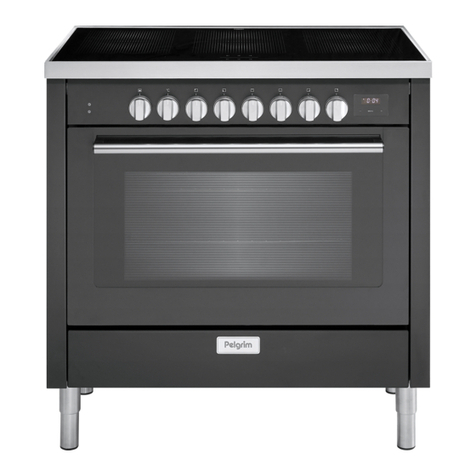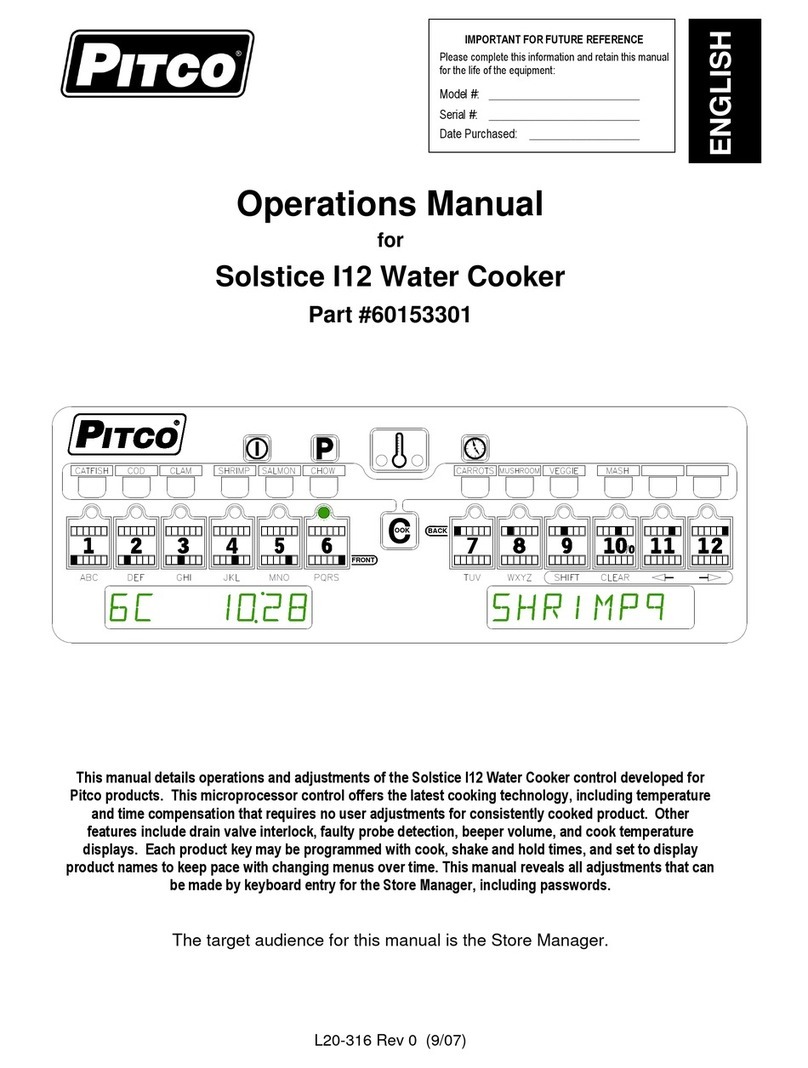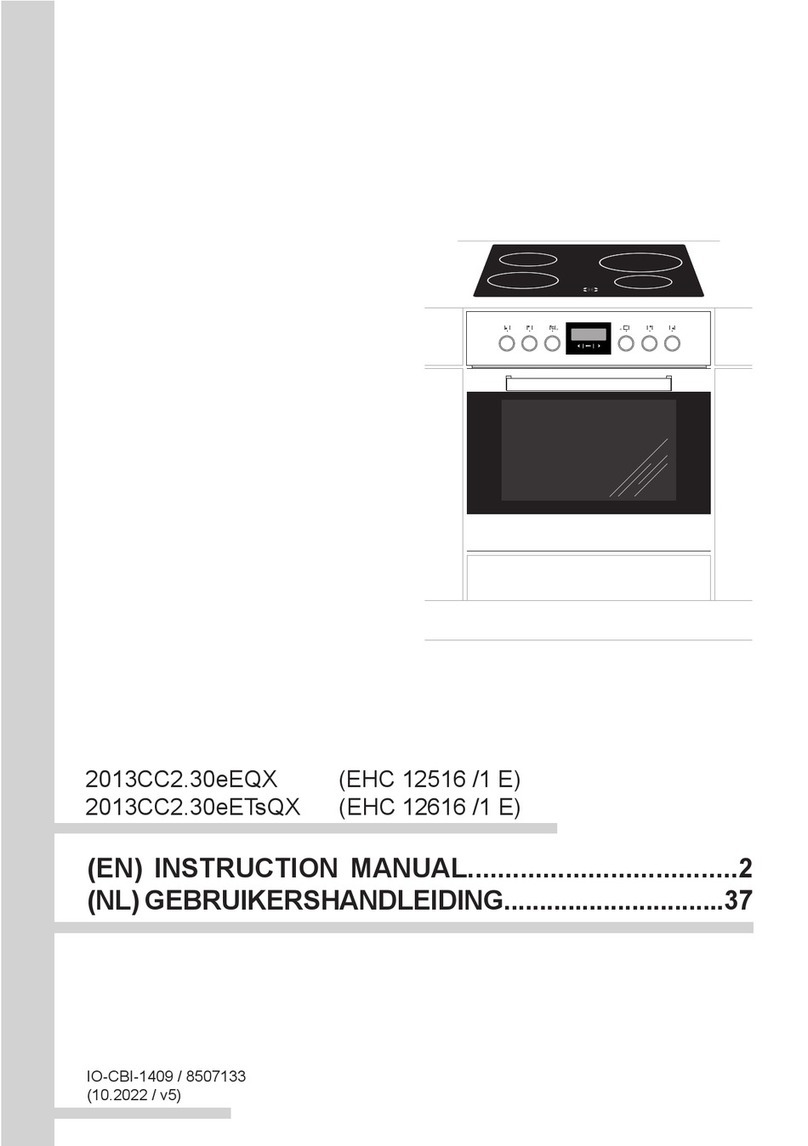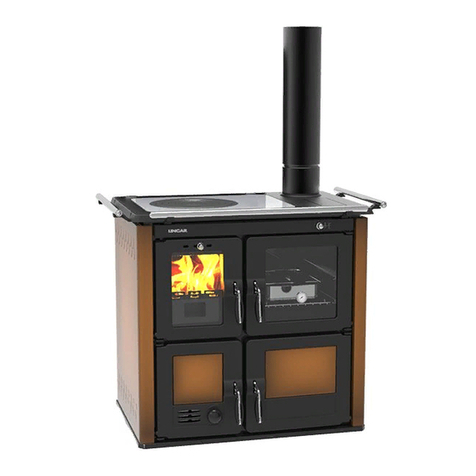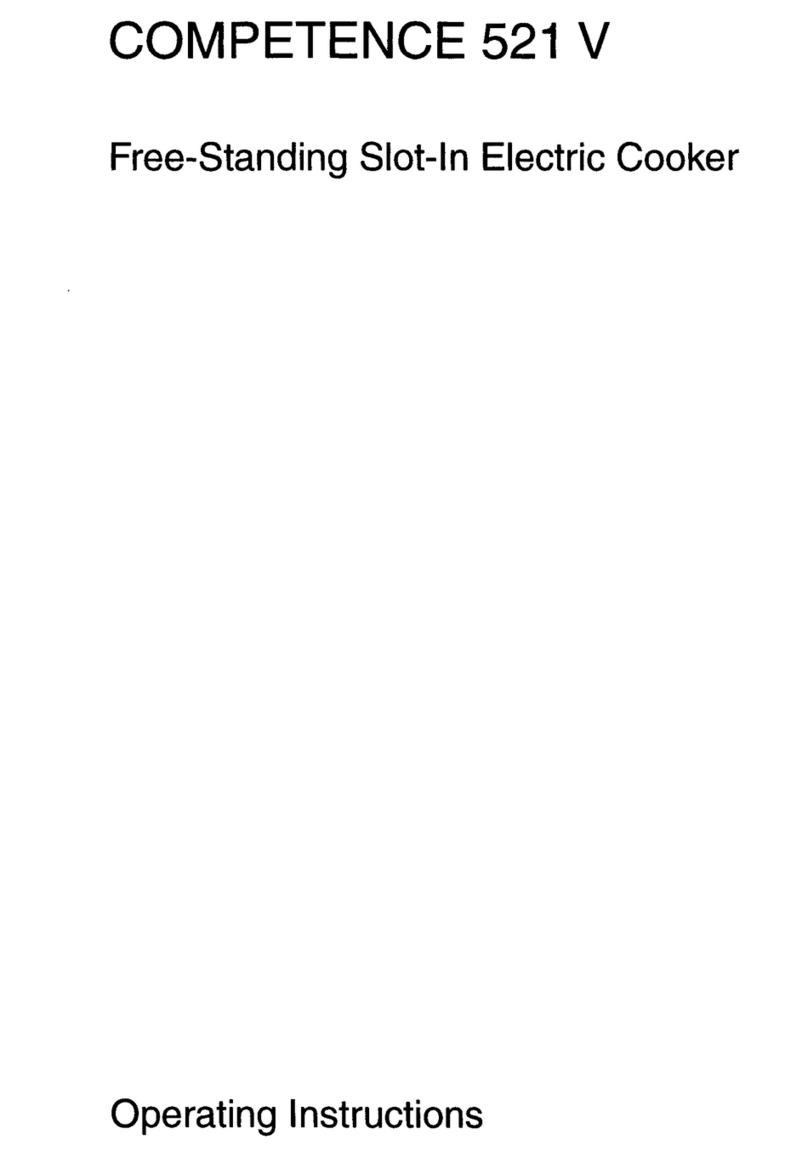Tisira TFCM629WE User manual

USER MANUAL
UPRIGHT COOKERS
TFCM629WE, TFEM629WE
IMPORTANT // Please ensure that you read through this user manual prior to installation and use. This manual
contains important information to ensure optimal performance and keep you safe. Please retain your proof of
purchase, as this will be required in the event that you require warranty service. Remember to retain this manual
for future reference.
www.tisira.com

pg 2pg 3
www.tisira.com | tisira tisira | www.tisira.com
CONTENTS
CONTENTS 2
WARNING & SAFETY INFORMATION 3-4
PRODUCT OVERVIEW 5-7
OPPERATING INSTRUCTIONS 8-14
MAINTAINING YOUR COOKER 15-19
INSTALLATION 20-23
TROUBLE SHOOTING 24-25
NOTES 26-27

pg 2pg 3
www.tisira.com | tisira tisira | www.tisira.com
WARNING & SAFETY
INFORMATION
• Read these instructions carefully before
installing or using this appliance.
• Do not modify this appliance.
• Do not store or use flammable materials
in the appliance storage drawer or near
this appliance.
• Servicing should be carried out only by
authorised personnel.
• Do not remove the plug by pulling the
cable.
• In order to prevent accidental tipping
of the appliance, for example by a child
climbing onto the open oven door, the
anti-tilting chain must be installed. Refer
to the instructions on page 23.
• To avoid burns, young children should be
kept away.
• This appliance is not intended for use by
persons (including children) with reduced
physical, sensory or mental capabilities,
or lack of experience and knowledge,
unless they have been given supervision
or instruction concerning use of the
appliance by a person responsible for
their safety.
• Children should be supervised to ensure
that they do not play with the appliance.
• Accessible parts may become hot when
the grill is in use. Children should be kept
away.
• Very important: keep this instruction
booklet with the appliance for handy
references.
• This appliance is designed for domestic
use only.
• Keep packaging out of reach of children
at all times.
• Never use your appliance as a work or
storage surface.
• Never use your appliance for warming or
heating the room.
• Do not use a steam cleaner to clean your
cooktop.
INSTALLATION
ELECTRICAL SHOCK HAZARD
• Disconnect the appliance from the mains
electricity supply before carrying out any
work or maintenance on it.
• Connection to a good earth wiring system
is essential and mandatory.
• Alterations to the domestic wiring
system must only be made by a qualified
electrician.
• Failure to follow this advice may result in
electrical shock or death.
CUT HAZARD
• Take care - panel edges are sharp.
• Failure to use caution could result in
injury or cuts.

pg 4pg 5
www.tisira.com | tisira tisira | www.tisira.com
WARNING & SAFETY
INFORMATION
OPERATION & MAINTENANCE
ELECTRICAL SHOCK HAZARD
• Do not cook on a broken or cracked
cooktop. If the cooktop surface should
break or crack, switch the appliance off
immediately at the mains power supply
(wall switch) and contact a qualified
technician.
• Switch the cooktop off at the wall before
cleaning or maintenance.
HEALTH HAZARD
• This appliance complies with
electromagnetic safety standards.
HOT SURFACE HAZARD
• During use, accessible parts of this
appliance will become hot enough to
cause burns.
• Do not let your body, clothing or any item
other than suitable cookware contact the
solid element cooking zones until the
surface is cool.
• Keep children away.
• Handles of saucepans may be hot to
touch. Check that saucepan handles do
not overhang other cooking zones that
are on. Keep handles out of reach of
children.
• Failure to follow this advice could result
in burns and scalds.

pg 4
pg 5
www.tisira.com | tisira
tisira | www.tisira.com
PRODUCT OVERVIEW
1. Cooktop plate
2. Thermostat knob
3. Command knob for oven
4. Command Knobs for Cooktop Zones
5. Oven door
6. Handle
7. Plastic leg
8. Lower cabinet door
8.1 Drawer
8.2 Flap door
9. Lamp
10. Wire rack
11. Ceramic heater (Ø140 mm / 250 mm)
12. Ceramic heater (Ø120 mm / 180 mm)
13. Ceramic heater (Ø140 mm or 180 mm)
14. Solid Hot plate (Ø145 mm or Ø185 mm)

pg 6
pg 7
www.tisira.com | tisira
tisira | www.tisira.com
PRODUCT OVERVIEW
CHOOSING THE RIGHT COOKWARE
Do not use cookware with jagged edges
or a curved base.
Make sure that the base of your pan is
smooth, sits flat against the surface, and is
the same size as the cooking zone. Always
centre your pan on the cooking zone.
Always lift pans off the electric hob – do
not slide, or they may scratch the surface.
CONTROL PANEL
1. Thermostat
2. Function selection button
3. Mechanical timer *
4. Rear left electrical heater
5. Front left electrical heater
6. Front right electrical heater
7. Rear right electrical heater

pg 6pg 7
www.tisira.com | tisira tisira | www.tisira.com
PRODUCT OVERVIEW
TECHNICAL FEATURES OF YOUR OVEN
SPECIFICATIONS 60 X 60
Outer width 600 mm
Outer depth 630 mm
Outer height 855 mm
Lamp power 15-25 W
Bottom heating element 1200 W
Top heating element 1000 W
Turbo heating element 2200 W
Grill heating element 2000 W
Supply voltage 220-240V AC/380-415V AC 50/60 Hz
Hot plate 145 mm 1000 W
Hot plate 180 mm 1500 W
Hot plate rapid 145 mm 1500 W
Hot plate rapid 180 mm 2000 W
Ceramic heater 140 mm 1200 W
Ceramic heater 180 mm 1700 W / 1800 W
Ceramic heater 140 mm / 250 mm 1800 W
Ceramic heater 120 mm / 180 mm 1700 W
NOTE // Keep the oven door closed while using the grill function.

pg 8
pg 9
www.tisira.com | tisira
tisira | www.tisira.com
OPPERATING
INSTRUCTIONS
INSTRUCTIONS FOR USE OF COOKTOP
•Read this guide, taking special note of the warning and safety information.
•Remove any protective film that may still be on your electric hob
USING YOUR ELECTRIC HOB
TO BEGIN COOKING
1. Place a suitable pan onto the cooking zone that you wish
to use.
NOTE // Make sure the bottom of the pan and the surface
of the cooking zone is clean and dry.
2. Place a suitable pan onto the cooking zone that you wish
to use.
“MAX“or “6” indicates the highest heat setting, “O” indicates
that the cooktop is off.
NOTE // This hob has four heating elements that are built
with thermal cut-off protection, and are thermostatically
controlled.
NOTE // The element will not operate at maximum power
continuously and will automatically drop to half the power
once the maximum heat has been reached.
WHEN YOU FINISH COOKING
Turn the heating zones off by positioning the heating zone controls to the “O” (off) position.

pg 8
pg 9
www.tisira.com | tisira
tisira | www.tisira.com
ADJUSTING THE SHELF/TRAY
POSITION
When adjusting or positioning your shelf,
please ensure the following:
1. Ensure that the shelf / tray is located
between the two wire sideracks. (See
point 1)
2. The shelf stops should be facing
downwards and towards the rear. (See
point 2)
3. The guard rail should always be located
at the rear of the oven (See point 3)
IMPORTANT // Prior to first time use,
it is recommended that you select the
Conventional Cooking function and set it to
work at its highest temperature (250ºC) for
half an hour without anything inside the oven
and with its the door shut. At the end of this
process, open the oven door and leave it
open for a few minutes to allow fresh air to
circulate inside the oven.
This procedure will remove the
unpleasant odour that is caused by
bonding agents used to protect the oven
cavity during the enamel coating stage.
NOTICE // Your oven is equipped with a
thermostatically controlled cooling fan
that will switch on when required to cool
the oven. This fan may continue to run
even after the oven is switched off, but it
will automatically turn off when the cavity
is sufficiently cool. Warm air is discharged
from the front of the oven during the
cooling process.
USING THE THERMOSTAT CONTROL
• Set the temperature by turning the
thermostat control to the desired level.
• When a temperature is selected,
thermostat light will illuminate.
• When the selected temperature is
reached, the light will turn off.
ATTENTION // During use, the appliance
becomes hot. Care should be taken to avoid
touching heating elements inside the oven.
NOTE // Never line the oven with
aluminium sheets as this can cause
damage to the enamel.
OPERATING
INSTRUCTIONS
INSTRUCTIONS FOR USE OF OVEN

pg 10
pg 11
www.tisira.com | tisira
tisira | www.tisira.com
OPERATING
INSTRUCTIONS
USING THE OVEN FUNCTION SELECTOR
SYMBOL FUNCTION DESCRIPTION
Light The light mode can be turned on with no heating elements
and will turn on with all oven functions.
Defrost Defrost mode distributes air at ambient temperature inside the
oven to defrost food quickly and without protein adulterations.
Fan-Assisted Grill
Fan-assisted Grill mode uses the grill element and oven
fan to cook meats, vegetables and poultry. In this mode,
heat is radiated down then spread throughout the oven. To
achieve the best results, use the middle tray position.
Grill
Grill mode should be used for melting cheese, toasting &
browning. Five minutes preheating is required to heat the
element. Use the upper shelf position for best results.
Fan Assisted
Convection
Fan-assisted convection mode is ideal for delicate foods
such as desserts. In this mode, the oven uses the oven fan,
bottom and top elements. It is recommended to use the
lower shelf position with this mode.
Natural Convection
Natural Convection mode utilises the top and bottom elements.
This function is recommended for use with the middle shelf
position and is good for slow cooking casseroles, etc.
Bottom Element
Bottom Element mode is recommended for cooking pastry
based dishes (flans, quiches and tarts) that require more
heat and radiation from below.
Top Element Top Element mode is recommended for dishes that require more
heat from the top; such as gratins, pies, quiches and lasagne.
Fan Forced Fan-forced mode cooks foods placed on up to 2 different
shelves.
MECHANICAL TIMER
Used for determining the period for cooking in the oven. When
adjusted time is expired, power to heaters is turned off and an audible
warnig signal is emitted. Mechanical timer can be adjusted to desired
period between 0-90 minutes.
For cooking periods, see cooking tables.

pg 10 pg 11
www.tisira.com | tisira tisira | www.tisira.com
The table below provides examples of the function,
temperature, tray position and estimated cooking times for
various types of food.
IMPORTANT // Please note that this table is a guide only and
times can vary according to the type of food, volume and quantity of food being cooked.
Preheating of the oven is recommended for 10-15 minutes or until the oven thermostat
light switches off to indicate that the selected temperature has been reached.
NATURAL CONVECTION
TABLE OF COOKING TIMES
Food to be cooked Tray
Position
Temperature
(°C)
Cooking time (mins)
BAKED GOODS
Small cakes 3 195 20-30
Victoria sponge cake 3 190 25-35
Swiss Roll 3 200 20-25
Fruit Cake 2 155 120-180
Scones 3 260 10-20
Meringues 2 95 120-180
Shortcrust Pastry 3 210 25-45
Puff/Flaky Pastry 2 220 20-35
Choux Pastry 3 220 25-35
Biscuits 3 200 15-25
Bread 2 250 30-40
Pudding 2 165 60-120
Pizza 3 270 25
Lasagne 3 170 75
OPERATING
INSTRUCTIONS

pg 12 pg 13
www.tisira.com | tisira tisira | www.tisira.com
OPERATING
INSTRUCTIONS
Food to be cooked Tray
Position
Temperature
(°C)
Cooking time (mins)
BAKED GOODS
Small cakes
All
Positions
175 15-25
Victoria sponge cake 170 20-30
Swiss Roll 180 15-20
Fruit Cake 135 60-120
Scones 210 8-15
Meringues 80 60-120
Food to be cooked Tray
Position
Temperature
(°C)
Cooking time (mins)
MEAT & POULTRY
Beef
(On the
bone)
Rare & Crusty
3
270 12 mins per 500g (+12 mins)
Rare 220 15 mins per 500g (+15 mins)
Medium 220 20 mins per 500g (+20 mins)
Well Done 180 25 mins per 500g (+25 mins)
Lamb
On the bone 220 20 mins per 500g (+20 mins)
De-boned and
rolled 170 27 mins per 500g (+27 mins)
Pork
On the bone 220 25 mins per 500g (+25 mins)
De-boned and
rolled 180 30 mins per 500g (+30 mins)
Veal
On the bone
220
25 mins per 500g (+25 mins)
De-boned and
rolled 30 mins per 500g (+30 mins)
Chicken 220 20 mins per 500g (+20 mins)
170 25 mins per 500g (+15 mins)
Turkey/Duck 220 20 mins per 500g (+20 mins)
170 25 mins per 500g (+15 mins)
FAN FORCED
NATURAL CONVECTION CONTINUED

pg 12 pg 13
www.tisira.com | tisira tisira | www.tisira.com
Food to be cooked Tray
Position
Temperature
(°C)
Cooking time (mins)
BAKED GOODS
Shortcrust Pastry
All
Positions
190 20-40
Puff/Flaky Pastry 200 15-30
Choux Pastry 200 20-30
Biscuits 170 10-20
Bread 200 25-35
Pudding 150 60-120
Pizza 250 20
Lasagne 165 60
MEAT & POULTRY
Beef
(On the
bone)
Rare &
Crusty
3
230 9 mins per 500g (+9 mins)
Rare 190 15 mins per 500g (+8 mins)
20 mins per 500g (+10 mins)
Medium 160 25 mins per 500g (+8 mins)
Well Done 190 20 mins per 500g (+10 mins)
Lamb
On the bone 155 27 mins per 500g (+14 mins)
De-boned
and rolled 200 25 mins per 500g (+14 mins)
Pork
On the bone 160 30 mins per 500g (+18 mins)
De-boned
and rolled 200 25 mins per 500g (+14 mins)
30 mins per 500g (+14 mins)
Veal
On the bone 200 20 mins per 500g (+10 mins)
De-boned
and rolled 155 25 mins per 500g (+13 mins)
Chicken 220 18 mins per 500g (+14 mins)
Turkey/Duck 155 23 mins per 500g
FAN FORCED CONTINUED
OPERATING
INSTRUCTIONS

pg 14
pg 15
www.tisira.com | tisira
tisira | www.tisira.com
OPERATING
INSTRUCTIONS
ACCESSORIES
The accessories can be inserted into the oven in 4
different shelf positions. They can be safely pulled
two-thirds of the way out of the oven.
BAKING AND ROASTING SHELF
Accessory Description
Tray / Glass tray
Used for pastry (cookie, biscuit etc.),
frozen foods.
Wire Grill
Used for roasting or placing foods to be
baked, roasted and frozen into desired
rack.
In Tray Wire Grill
Foods that stick while cooking such as
steak are placed on in tray grill. Thus
contact of food with tray and sticking
are prevented. 5

pg 14 pg 15
www.tisira.com | tisira tisira | www.tisira.com
MAINTAINING YOUR
COOKER
MAINTENANCE AND CLEANING -
OVEN
Before any operation disconnect the
appliance from the power supply and wait
for it to cool down.
• Do not use steam cleaner
• Do not use harsh abrasive cleaners,
flammable agents (such as acid) or sharp
metal scrapers to clean this appliance.
• Wash the enamelled parts with
lukewarm water and detergent
• Rinse the stainless steel parts well with
water and dry them with a soft cloth
• To clean the hob use slightly damp
sponges and wiping cloths: if too much
water is used it could penetrate the
internal parts and damage electrical parts.
• For persistent stains use normal non-
abrasive detergents, or hot vinegar
• Clean the glass parts with hot water
and a soft cloth
• It is necessary to clean the oven after
each use
• Once the oven is cold, you will be
able to remove the fat deposits with
a sponge or a cloth damp with warm
soapy water or a common detergent.
• In order to clean the front glass lid of
the oven; remove the fixing screws
fixing the handle by means of a
screwdriver and remove the oven door.
Then clean and rinse it thoroughly.
After drying, place the oven glass
properly and re-install the handle.
MAINTENANCE AND CLEANING-
CERAMIC GLASS SURFACES
• Never pour cold water on hot cookers.
• Do not stand on a ceramic glass plate.
• Sudden pressure, for example, the
effect of a falling salt shaker may be
critical. So, do not place such objects
on a place above the hobs.
• After each use, make sure that the
base of the cooking pot and surfaces of
cooking zones are clean and dry.
• Do not peel vegetables on the hob
surfaces. Sand grains falling from the
vegetables may scratch the ceramic
glass plate.
• Do not lay flammable materials such
as cardboard or plastic on the oven.
Objects such as tin, zinc, or aluminium
(as well as aluminium foils or empty
coffee pots) may melt on hot cooking
surfaces and thus cause damage.
• Take care not to let sugary foods or
fruit juices contact the hot cooking
zones. The ceramic glass surface may
be stained by these.
Always clean the appliance immediately
after any food spillage.
To maintain safe operation, it is
recommended that the product be
inspected every five years by an authorised
service person.
Note // See illustration on page 17

pg 16 pg 17
www.tisira.com | tisira tisira | www.tisira.com
MAINTAINING YOUR
COOKER
MAINTENANCE AND CLEANING - SOLID ELEMENT HOTPLATES
Concern Steps to follow Explanation
Everyday soiling on the
surface (fingerprints,
marks, stains left by food or
nonsugary spill-overs on the
surface)
1. Switch the power to the
cooktop off
2. Apply a cooktop cleaner
while the cooktop is still
warm (but not hot!)
3. Rinse and wipe dry with a
clean cloth or paper towel
4. Switch the power to the
cooktop back on
• When the power to the
cooktop is switched off, the
cooking zone may still be
hot! Take extreme care as
there is no “hot surface”
indication.
• Heavy-duty scourers,
some nylon scourers and
harsh/ abrasive cleaning
agents may scratch the
surface. Always read
the label to check if your
cleaner or scourer is
suitable.
• Never leave cleaning
residue on the cooktop:
the surface may become
stained.
Spill-overs on
the heating zone
controls
5. Switch the power to the
cooktop off
6. Soak up the spill
7. Wipe the control panel
area with a clean damp
sponge or cloth
8. Wipe the area completely
dry with a paper towel.
9. Switch the power to the
cooktop back on
• Ensure that the control
panel area is wiped dry
before the cooktop is
turned back on.

pg 16
pg 17
www.tisira.com | tisira
tisira | www.tisira.com
MAINTAINING YOUR
COOKER
INSTALLATION OF THE OVEN DOOR
In order to re-place the oven door, perform the above mentioned steps in reverse.
Figure 2 Figure 3
Figure 2.1
Completely open the
oven door by pulling it
to yourself. Afterwards,
perform the unlocking
process by pulling the
hinge lock upwards
with the help of a screw
driver as shown in
Figure 2.1
Figure 2.2
Bring the hinge lock
to the widest angle
as shown in Figure
2.2. Bring both hinges
connecting the oven
door to the oven to the
same position.
Figure 3.1
Afterwards, close the
oven door as to lean
on the hinge lock as
shown in Figure 3.1.
Figure 3.2
To remove the oven
door, pull it upwards
by holding it with both
hands when close to
the closed position as
shown in Figure 3.2.

pg 18
pg 19
www.tisira.com | tisira
tisira | www.tisira.com
CLEANING AND MAINTENANCE OF THE OVEN’S FRONT DOOR GLASS
Remove the profile by pressing the plastic latches on both left and right sides as shown in
Figure 4 and pulling the profile towards yourself as shown in Figure 5. Then remove the
inner-glass as shown in Figure 6. If required, middle glass can be removed in the same
way. After cleaning and maintenance are done, remount the glasses and the profile in
reverse order. Make sure the profile is properly seated in its place.
CATALYTIC WALLS
Catalytic walls are located on the left and
the right side of cavity under the guides.
Catalytic walls banish the bad smell and
obtain the best performance from the
cooker. Catalytic walls also absorb oil
residue and clean your oven while it’s
operating.
REMOVING THE CATALYTIC WALLS
In order to remove the catalytic walls;
the guides must be pulled out. As soon
as the guides are pulled out, the catalytic
walls will be released automatically. The
catalytic walls must be changed after 2-3 years.
MAINTAINING YOUR
COOKER
Figure 4 Figure 5 Figure 6

pg 18
pg 19
www.tisira.com | tisira
tisira | www.tisira.com
RACK POSITIONS
It is important to place the wire grill into the oven properly.
Do not allow wire rack to touch rear wall of the oven. Rack
positions are shown in the next figure. You may place a deep
tray or a standard tray in the lower and upper wire racks.
INSTALLING AND REMOVING WIRE RACKS
To remove wire racks, press the clips shown with arrows in the figure, first remove the
lower, and than the upper side from installation location. To install wire racks; reverse the
procedure for removing wire rack.
CHANGING THE OVEN LAMP
WARNING // To avoid electric shock, ensure that the appliance circuit is open before
changing the lamp. (having circuit open means power is off) First disconnect the power
of appliance and ensure that appliance is cold. Remove the glass protection by turning as
indicated in the figure on the left side. If you have difficulty in turning, then using plastic
gloves will help you in turning.
Then remove the lamp by turning, install the new lamp with same specifications.
Reinstall glass protection, plug the power cable of appliance into electrical socket and
complete replacement. Now you can use your oven.
MAINTAINING YOUR
COOKER
220-240 V, AC
15-25 W
TYPE G9 LAMP TYPE E14 LAMP
Figure 8 Figure 9
220-240 V, AC
15 W

pg 20
pg 21
www.tisira.com | tisira
tisira | www.tisira.com
INSTALLATION
ELECTRICAL CONNECTION
• Your oven requires 40 Amp fuse for mono phase or 3x16 Amp fuse for 3 phase supply
according to electrical power for cooker section has 4 ceramic heater and oven section has
electric models. Installation by a qualified electrician is mandatory.
• Your oven is adjusted in compliance with 220-240V / 380-415V AC,50/60Hz. electric supply.
If the mains are different from this specified value, contact your authorized service.
• Electrical connection of the oven should only be made to connections / sockets with an
earth system installed in compliance with local regulations.
• If there are no connections/sockets with an earth system in place where the oven will be
installed, immediately contact a qualified electrician to install. The manufacturer is not
responsible for damages that will arise because of the appliance not be connected to an
earth system.
• If your supply cable gets damaged, it should be replaced by an authorized service agent or
qualified electrician in order to avoid danger or electric shock.
• Electrical cable should not touch the hot parts of the appliance.
• Operate your oven in dry atmosphere.
• When placing your oven to its location, ensure that it is at the counter level. Bring it to the
counter level by adjusting the feet if necessary.
This manual suits for next models
1
Table of contents
Other Tisira Cooker manuals
Popular Cooker manuals by other brands

Bosch
Bosch HGW3FSY50Z User manual and installation instructions
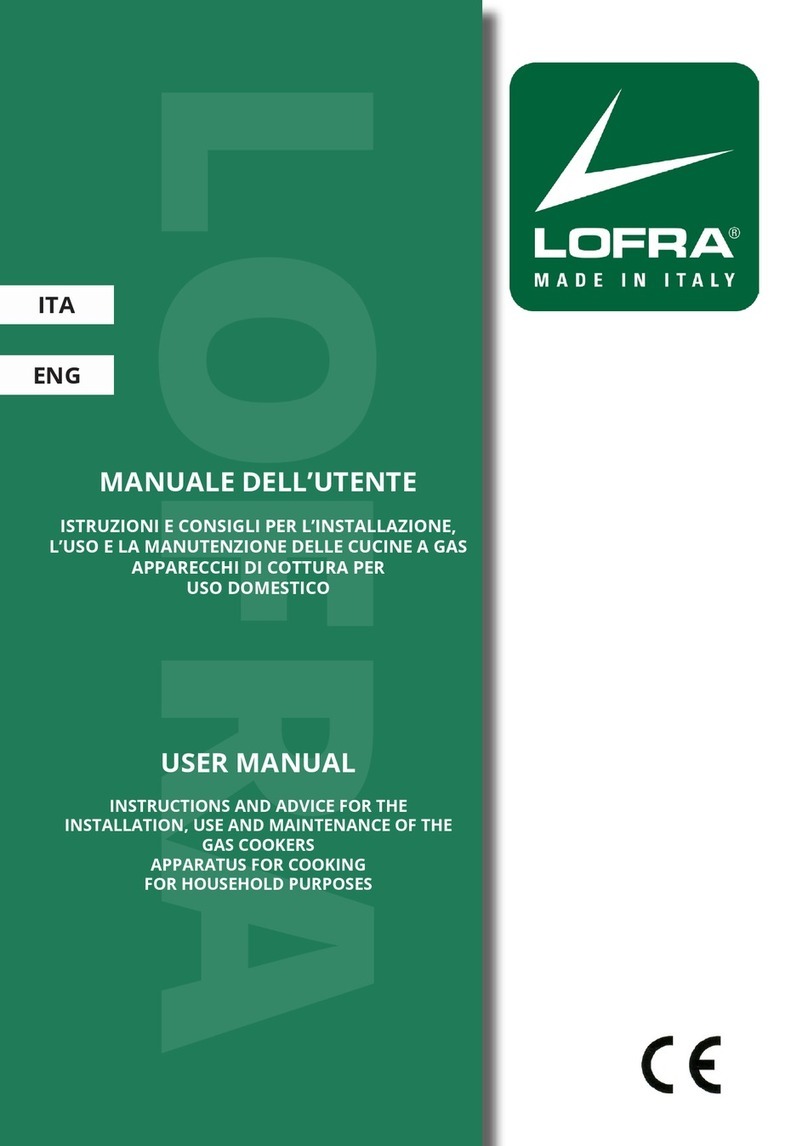
Lofra
Lofra UDV66MFE Series user manual

Siemens
Siemens HR74W530J instruction manual
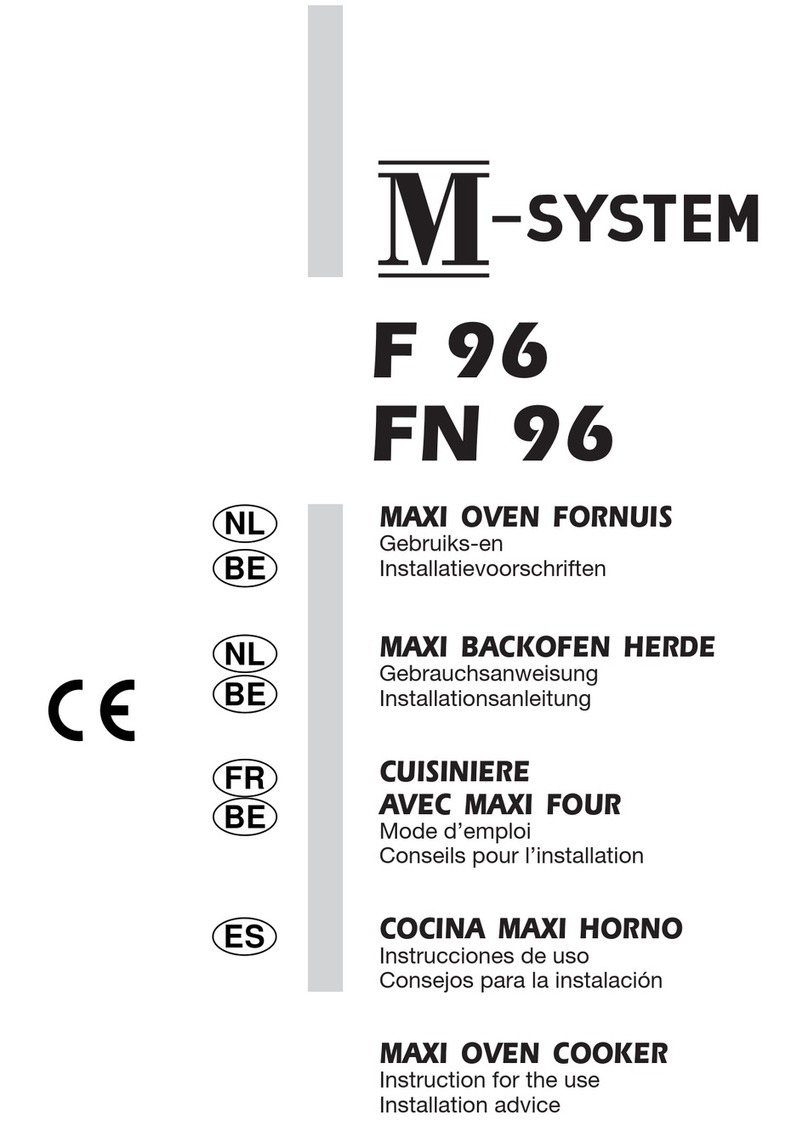
M-system
M-system FN 96 Instruction for the use - installation advice

Parkinson Cowan
Parkinson Cowan SG 428 Operating and installation instructions
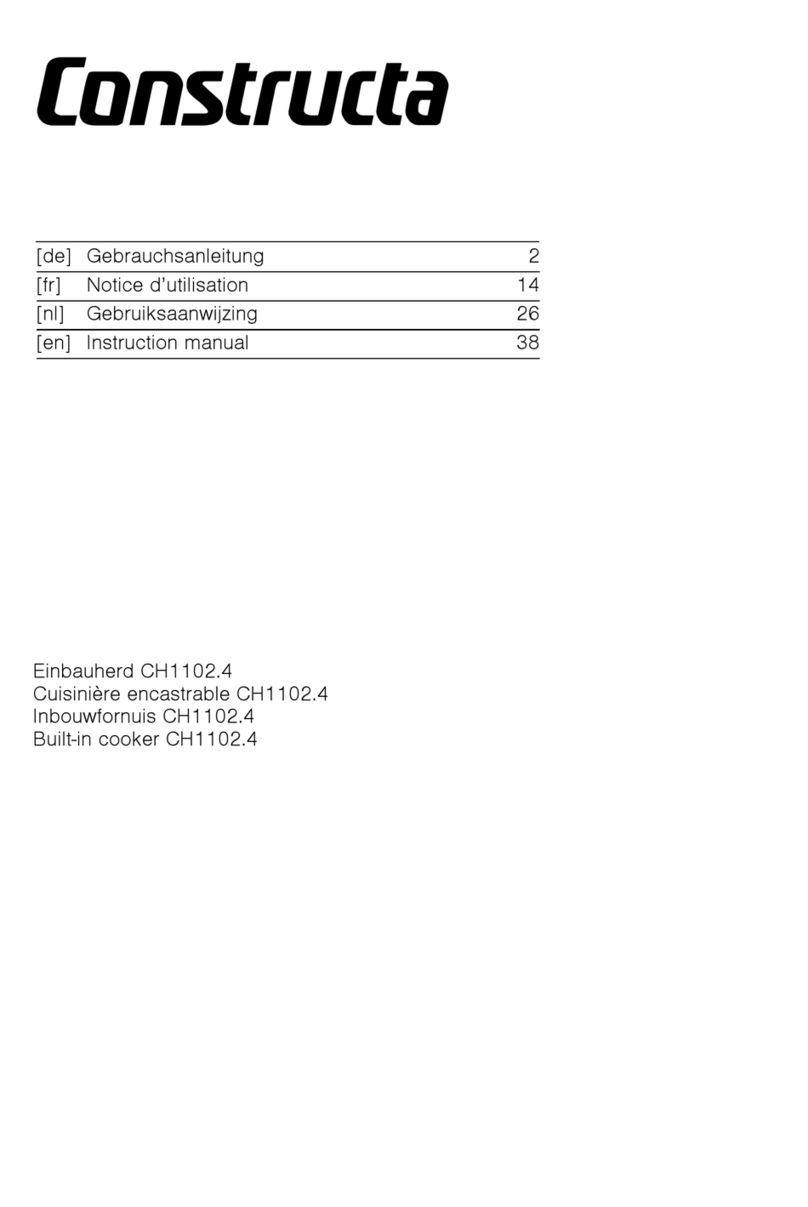
CONSTRUCTA
CONSTRUCTA CH1102.4 instruction manual
